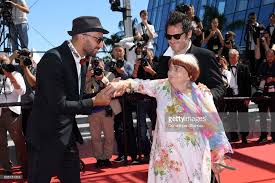They Put Faces on Places
By Cynthia Citron
She is a little dumpling of a woman, 88 years old, with a cap of snow-white hair bordered by a heavy fringe of orange hair that hangs all around her head like a silken scarf.
He is a lanky 33 year old with a mustache, a permanently placed hat and a pair of dark glasses that he never removes.
She is Agnes Varda, whose “occupation” is listed in Wikipedia as “director, screenwriter, editor, actor, producer, installation artist, and photographer.”
But mostly she is celebrated for her acknowledged role as “mother of the French New Wave”—that group of French auteurs that in the 1950s and 60s revolutionized attitudes and techniques in filmmaking.
A photographer first, Varda then developed all the other skills she needed to make films.
She introduced “realism” and her musings on life and death into her films and developed stories that were documentary in style, feminist in viewpoint, and full of her own high spirits.
He is JR, a renowned photographer whose black and white murals have thrilled more than 150,000 people in 108 countries around the world. Having started out as a teenage graffiti artist, he now calls himself an “urban artivist” as he expands his portraits to include not only individuals and groups, but also the places where they live and work.
Although he is a recognized artist, he retains his anonymity
by using his initials as a pseudonym, and even Wikipedia notes that his identity is unconfirmed (although they suggest his name might be Jean Rene and they identify his wife as someone named Prune Nourry).
In 2011 JR won the prestigious TED prize and with the $100,000 award he bought a photobooth truck and started what he called The Inside Out Project. And it was on a journey through the tiny villages and deserted factories of rural France that Agnes Varda joined him, and the film they made together is called “Faces Places”.
They would seem to be an unlikely pair of friends, but friends they are. Warm and affectionate and full of complementary creative juices.
They traveled to towns that nobody’s ever heard of and they made friends wherever they went.
They took photographs of townspeople and farmers and miners and a bell-ringer at work and they enlarged the photos to a size so huge that they covered the whole side of a building when they were pasted on the wall.
They pasted a farmer’s photo to cover the entire front of his barn and the photo of an older woman peeking out at them from behind lace curtains that was enlarged to run the length of her house.
They took groups of people in various poses, smiling happily, and a boy sitting and sleeping whose photo was mounted on the side of a German bunker left over from World War Two. But when they returned to it the next day they found that the rising tide had washed the whole tableau away.
They talked as they drove together in the gray fog of a French winter and they recorded the everyday conversations they had with the people they met and interviewed.
The countryside was mesmerizing in spite of the persistent grayness, because every time the camera focused on Agnes Varda, the whole screen lit up in the glow of her beautiful face.
And that’s about all there is to the film. Except it’s one of the most beautiful and emotionally absorbing documentaries I’ve ever seen.
“Faces Places” will open tomorrow, Friday, October 13, in Los Angeles. I sincerely hope you’ll love it as much as I did!









